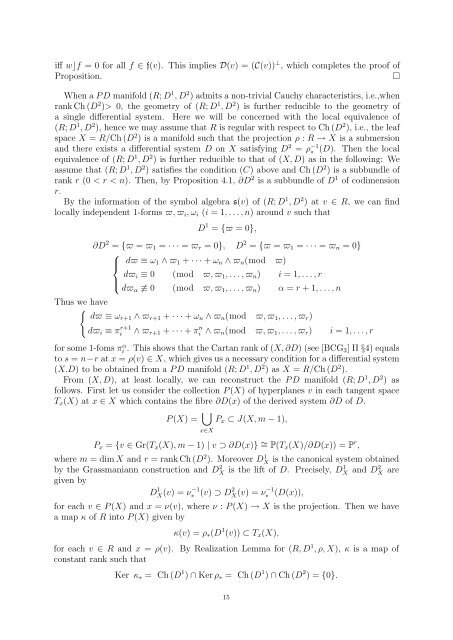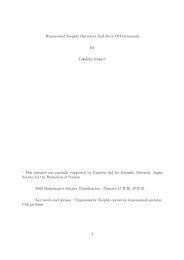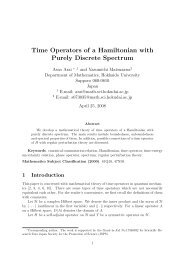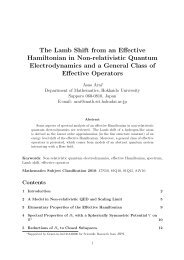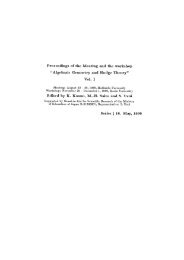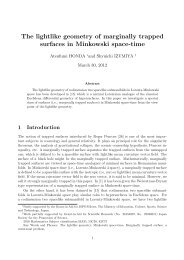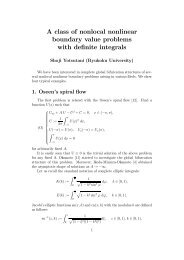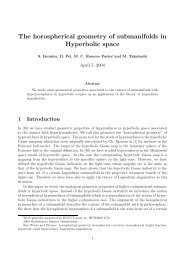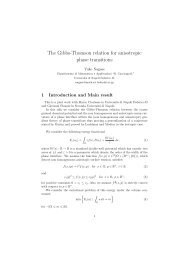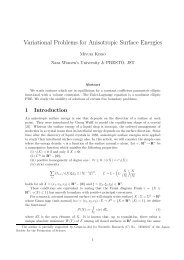Contact Geometry of second order I - Dept. Math, Hokkaido Univ ...
Contact Geometry of second order I - Dept. Math, Hokkaido Univ ...
Contact Geometry of second order I - Dept. Math, Hokkaido Univ ...
You also want an ePaper? Increase the reach of your titles
YUMPU automatically turns print PDFs into web optimized ePapers that Google loves.
iff w⌋f = 0 for all f ∈ f(v). This implies D(v) = (C(v)) ⊥ , which completes the pro<strong>of</strong> <strong>of</strong><br />
Proposition. <br />
When a P D manifold (R; D 1 , D 2 ) admits a non-trivial Cauchy characteristics, i.e.,when<br />
rank Ch (D 2 )> 0, the geometry <strong>of</strong> (R; D 1 , D 2 ) is further reducible to the geometry <strong>of</strong><br />
a single differential system. Here we will be concerned with the local equivalence <strong>of</strong><br />
(R; D 1 , D 2 ), hence we may assume that R is regular with respect to Ch (D 2 ), i.e., the leaf<br />
space X = R/Ch (D 2 ) is a manifold such that the projection ρ : R → X is a submersion<br />
and there exists a differential system D on X satisfying D 2 = ρ −1<br />
∗ (D). Then the local<br />
equivalence <strong>of</strong> (R; D 1 , D 2 ) is further reducible to that <strong>of</strong> (X, D) as in the following: We<br />
assume that (R; D 1 , D 2 ) satisfies the condition (C) above and Ch (D 2 ) is a subbundle <strong>of</strong><br />
rank r (0 < r < n). Then, by Proposition 4.1, ∂D 2 is a subbundle <strong>of</strong> D 1 <strong>of</strong> codimension<br />
r.<br />
By the information <strong>of</strong> the symbol algebra s(v) <strong>of</strong> (R; D 1 , D 2 ) at v ∈ R, we can find<br />
locally independent 1-forms ϖ, ϖi, ωi (i = 1, . . . , n) around v such that<br />
D 1 = {ϖ = 0},<br />
∂D 2 = {ϖ = ϖ1 = · · · = ϖr = 0}, D 2 = {ϖ = ϖ1 = · · · = ϖn = 0}<br />
⎧<br />
⎪⎨<br />
dϖ ≡ ω1 ∧ ϖ1 + · · · + ωn ∧ ϖn(mod ϖ)<br />
dϖi ≡ 0<br />
⎪⎩<br />
dϖα ≡ 0<br />
(mod<br />
(mod<br />
ϖ, ϖ1, . . . , ϖn)<br />
ϖ, ϖ1, . . . , ϖn)<br />
i = 1, . . . , r<br />
α = r + 1, . . . , n<br />
Thus we have<br />
{ dϖ ≡ ωr+1 ∧ ϖr+1 + · · · + ωn ∧ ϖn(mod ϖ, ϖ1, . . . , ϖr)<br />
dϖi ≡ π r+1<br />
i ∧ ϖr+1 + · · · + π n i ∧ ϖn(mod ϖ, ϖ1, . . . , ϖr) i = 1, . . . , r<br />
for some 1-foms π α i . This shows that the Cartan rank <strong>of</strong> (X, ∂D) (see [BCG3] II §4) equals<br />
to s = n−r at x = ρ(v) ∈ X, which gives us a necessary condition for a differential system<br />
(X.D) to be obtained from a P D manifold (R; D 1 , D 2 ) as X = R/Ch (D 2 ).<br />
From (X, D), at least locally, we can reconstruct the P D manifold (R; D 1 , D 2 ) as<br />
follows. First let us consider the collection P (X) <strong>of</strong> hyperplanes v in each tangent space<br />
Tx(X) at x ∈ X which contains the fibre ∂D(x) <strong>of</strong> the derived system ∂D <strong>of</strong> D.<br />
P (X) = ∪<br />
Px ⊂ J(X, m − 1),<br />
x∈X<br />
Px = {v ∈ Gr(Tx(X), m − 1) | v ⊃ ∂D(x)} ∼ = P(Tx(X)/∂D(x)) = P r ,<br />
where m = dim X and r = rank Ch (D2 ). Moreover D1 X is the canonical system obtained<br />
by the Grassmaniann construction and D2 X is the lift <strong>of</strong> D. Precisely, D1 X and D2 X are<br />
given by<br />
D 1 X(v) = ν −1<br />
∗ (v) ⊃ D 2 X(v) = ν −1<br />
∗ (D(x)),<br />
for each v ∈ P (X) and x = ν(v), where ν : P (X) → X is the projection. Then we have<br />
a map κ <strong>of</strong> R into P (X) given by<br />
κ(v) = ρ∗(D 1 (v)) ⊂ Tx(X),<br />
for each v ∈ R and x = ρ(v). By Realization Lemma for (R, D 1 , ρ, X), κ is a map <strong>of</strong><br />
constant rank such that<br />
Ker κ∗ = Ch (D 1 ) ∩ Ker ρ∗ = Ch (D 1 ) ∩ Ch (D 2 ) = {0}.<br />
15


